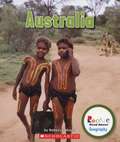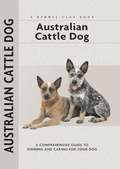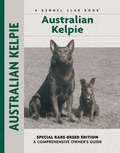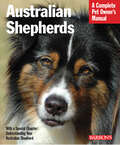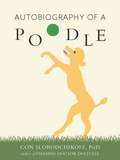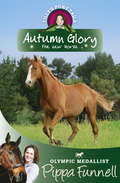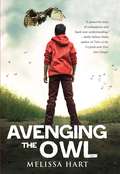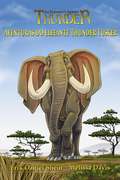- Table View
- List View
Aunt Eater Loves a Mystery (I Can Read #Level 2)
by Doug CushmanAunt Eater loves mystery stories so much that she sees mysterious adventures wherever she looks
Aunt Isabel Tells a Good One
by Kate DukePenelope and her Aunt Isabel make up an exciting bedtime story about the adventures of Prince Augustus and Lady Nell.
Aunt Isabel Tells a Good One (Into Reading, Trade Book #4)
by Kate DukeNIMAC-sourced textbook <P><P>Penelope and her Aunt Isabel make up an exciting bedtime story about the adventures of Prince Augustus and Lady Penelope.
Aurora: . (Los Gatos Guerreros | La Nueva Profecía #Volumen 3)
by Erin Hunter¿Se pondrán de acuerdo los clanes en cuanto a la mejor solución para abordar el problema que les plantea la Profecía? Aurora es la tercera entrega de «Los Gatos Guerreros | La Nueva Profecía». Los jóvenes gatos que partieron en una misión varias lunas atrás han regresado con un mensaje alarmante: los clanes deben trasladarse a un nuevo hogar, o se arriesgan a ser aniquilados. Pero los gatos no saben adónde ir, pues sospechan que más allá de sus fronteras los aguardan múltiples peligros y amenazas imprevisibles. Además, dada la férrea independencia de los clanes, ponerse de acuerdo sobre el rumbo a tomar resulta una tarea ímproba. Así pues, lo que necesitan es una señal del Clan Estelar... «La Nueva Profecía» es la segunda saga de «Los Gatos Guerreros», una serie que se ha traducido ya a 36 idiomas, lleva vendidos más de 30 millones de ejemplares en todo el mundo y ha permanecido durante más de dos años en la lista de grandes éxitos de The New York Times.
Auston the Sidecar Dog in Outer Space
by Wayne SumblerFollow Auston the Sidecar Dog and his daddy as they reach for the stars! Learn about the Moon, Mars and his thrilling ride through space, from lift-off to splash down. Follow Auston and his travels on YouTube as well. This book aims to inspire young readers to pursue future careers as astronauts or within the space industry.
Austral Ark
by Norman Maclean Adam Stow Norman Maclean Gregory I. Holwell Adam StowAustralia and New Zealand are home to a remarkable and unique assemblage of flora and fauna. Sadly though, by virtue of their long isolation, and a naïve and vulnerable biota, both countries have suffered substantial losses to biodiversity since European contact. Bringing together the contributions of leading conservation biologists, Austral Ark presents the special features and historical context of Austral biota, and explains what is being conserved and why. The threatening processes occurring worldwide are discussed, along with the unique conservation problems faced at regional level. At the same time, the book highlights many examples of conservation success resulting from the innovative solutions that have been developed to safeguard native species and habitats in both New Zealand and Australia. Austral Ark fills an important gap regarding wildlife gains and declines, and how best to take conservation forward to keep this extraordinary area of the world thriving.
Australia (Rookie Read-About Geography)
by Rebecca E. HirschPresents a simple introduction to Australia, focusing on its geographical features, people and native animals.
Australian Cattle Dog
by Charlotte SchwartzThis Comprehensive Owner's Guide to the Australian Cattle Dog serves as a complete introduction to Blue Heeler from Down Under. Regarded in Australia as the island nation's pride and joy, the Australian Cattle Dog knows no peer as a working herding dog, capable of controlling the most difficult stock in the punishing environs of its native land. Today the breed excels in various arenas beyond its bred-for ranching job, and the book traces the breed's fascinating origins and shows how the Australian Cattle Dog has become the most versatile dog on the planet. Beyond the history of the breed, the book includes chapters on characteristics and the breed standard encapsulating all of the virtues of this active breed, offering sound advice about which owners are best suited to own the nonstop AuCaDo. New owners will welcome the well-prepared chapter on finding a breeder and selecting a healthy, sound puppy. Chapters on puppy-proofing the home and yard, purchasing the right supplies for the puppy as well as house-training, feeding, and grooming are illustrated with handsome adults and puppies bursting with attitude and personality! In all, there are over 135 photographs in this compact, useful, and reliable volume. The author's advice on obedience training the quick-minded (and quick-moving) AuCaDo will help readers better mold and train their dogs into the most socialized, well-mannered dog in the neighborhood. The extensive chapter on healthcare provides up-to-date detailed information on selecting a qualified veterinarian, vaccinations, parasites, infectious diseases, and more. Chapters on showing and participating in dog sports as well as solving common behavior issues (such as barking, digging, etc.) will prove informative to the new owner. Sidebars throughout the text offer helpful hints, covering topics as diverse as historical kennels, toxic plants, first aid, crate training, carsickness, fussy eaters, and parasite control. Fully indexed.
Australian Kelpie
by Charlotte SchwartzA nineteenth-century Australian creation, the Kelpie is a working dog through and through. Handsome and trainable though he may be, the breed rarely excels as a house pet and is truly at "home on the range." The breed's intense herding instincts, pulsing through the brain and veins of every dog, directs the Kelpie to round up, race and rally every moving thing in his path. Here is an intelligent, independent-thinking dog with a one-track mind: the Kelpie has irrepressible devotion to his work.Written by award-winning canine journalist and author Charlotte Schwartz, this Special Rare-Breed Edition tells the unique story of the Kelpie in its homeland Down Under, detailing the breed's characteristics, origin and description. As the breed's working standard describes, the Kelpie should be "a medium sized, lithe, active, strongly muscled dog" who possesses an "open, friendly, active but placid disposition." The author discusses the selection of a Kelpie puppy and the general maintenance of the dog, including feeding, grooming and exercising. The key to keeping Kelpies is keeping them busy and avoiding boredom at all costs. The author warns pet owners about the potential behavioral problems that can develop in the bored Kelpie and advises how to avoid these issues. A thorough, up-to-date chapter on canine healthcare by veterinarian Dr. Lowell Ackerman provides essential information about inoculations, infectious diseases, parasite prevention and much more.
Australian Shepherd
by Charlotte SchwartzThis Comprehensive Owner's Guide to the Australian Shepherd serves as a complete introduction to this all-American wonder dog with the Australian name! Designed by ranchers in America's wide West, the Aussie, as his many friends call him, is a multi-talented herding dog that is admired as much for his flawless work ethic as for his natural beauty and engaging personality. Author Charlotte Schwartz, a highly regarded dog trainer and owner, begins this informative volume with a chapter on the breed's evolution from imported Spanish and French herding dogs to the American original it has become. The author continues with chapters on characteristics and the breed standard encapsulating all of the virtues of this versatile herding breed, offering sound advice about which owners are best suited to own this potentially challenging breed.New owners will welcome the well-prepared chapter on finding a breeder and selecting a healthy, sound puppy. Chapters on puppy-proofing the home and yard, purchasing the right supplies for the puppy as well as house-training, feeding, and grooming are illustrated with handsome adults and puppies bursting with energy and personality! In all, there are over 135 photographs in this compact, useful, and reliable volume. The author's advice on obedience training the eager-to-please Aussie will help readers better mold and train their dogs into the most socialized, well-mannered purebred dog in the neighborhood. The extensive chapter on healthcare provides detailed information on selecting a qualified veterinarian, vaccinations, parasites, infectious diseases, and more. Sidebars throughout the text offer helpful hints, covering topics as diverse as toxic plants, bloat, first aid, crate training, carsickness, fussy eaters, and parasite control. Fully indexed.
Australian Shepherd Dog
by Christina Cox-EvickDedicated to the Australian Shepherd, the world's most hard-working herding dog and the brightest family dog on the planet, this Smart Owner's Guide, created by the editors at Dog Fancy magazine, offers the most up-to-date and accurate information every dog owner needs to become a well-informed caregiver for his dog. Illustrated with color photographs of adorable puppies and handsome adults, this easy-to-read primer is designed in a modern, lively manner that readers will find user-friendly and entertaining.Each Smart Owner's Guide offers a description of the breed's character and physical conformation, historical overview, and its attributes as a companion dog. The reader will find informative chapters on everything he or she needs to know about acquiring, raising, and training this remarkable purebred dog, including: finding a breeder and selecting a healthy, sound puppy; preparing for the puppy's homecoming, shopping for supplies, and puppy-proofing the home; house-training; veterinary and home health maintenance; feeding and nutrition; and grooming. Obedience training for basic cues (sit, stay, heel, come, etc.) and solving potential problem behaviors (barking, chewing, aggression, jumping up, etc.) are addressed in separate chapters, as are activities to enjoy with the dog, including showing, agility, therapy work, and more.Entertaining tidbits and smart advice fill up colorful sidebars in every chapter, which the editors call "It's a Fact," "Smart Tip," "Notable & Quotable," and "Did You Know?" Real-life heroes and rescue stories are retold in full-page features called "Pop Pups" and "True Tails." Recipes, training, and care tips are highlighted in the "Try This" feature pages.The Smart Owner's Guide series is the only series that offers readers an online component in which dog owners can join a breed-specific online club hosted by dogchannel.com. At Club Aussie, owners of the breed can find forums, blogs, and profiles to connect with other breed owners, as well as charts and checklists that can be downloaded. More than just 20,000 pages of solid information, there's a host of fun to be had at the club in the form of downloadable breed-specific e-cards, screensavers, games, and quizzes.The Resources section of the book includes contact information for breed-related organizations and rescues, as well as practical guidance on traveling with dogs, identification, and locating qualified professionals to assist the dog owner, such as pet sitters, trainers, and boarding facilities. This information-packed Smart Owner's Guide is fully indexed.
Australian Shepherds (Complete Pet Owner's Manuals)
by Caroline Coile Ph.D.Discover expert advice about owning an Australian Shepherd, also known as an Aussie, so it lives a happy and healthy life. This title, along with all books in the comprehensive and popular B.E.S. Complete Pet Owner's Manuals series, provides advice on feeding, health care, housing, and all other important aspects of responsible pet ownership. Each title in the series is individually written from first page to last by a pet trainer, veterinarian, or other pet-care specialist. All Complete Pet Owner's Manuals are filled with high-quality photos and instructive line art.
Australian Terrier
by Muriel P. Lee Isabelle Francais Carol Ann JohnsonThis Comprehensive Owner's Guide to the Australian Terrier serves as a complete introduction to Australia's best-kept secret. One of Australia's five indigenous purebred dogs, the Australian Terrier ranks high among the world's working terriers and naturally excels as a fun, devoted family dog. Terrier breed authority, Muriel P. Lee provides an insightful chapter on the breed's history Down Under and its development in the States as well as engaging chapters on the characteristics and the breed standard, encapsulating all of the virtues of this happy terrier breed with the hard-bitten, rugged appearance. She offers sound advice about which owners are best suited to own the Australian Terrier, based on the breed's temperament and requirements.New owners will welcome the well-prepared chapter on finding a breeder and selecting a healthy, sound puppy. Chapters on puppy-proofing the home and yard, purchasing the right supplies for the puppy as well as house-training, feeding, and grooming are illustrated with handsome adults and puppies bursting with energy and personality! In all, there are over 135 photographs in this compact, useful, and reliable volume. The author's advice on obedience training the game and ready Aussie will help readers better mold and train their dogs into the most socialized, well-mannered terrier in the neighborhood. The extensive chapter on healthcare written by Harvard vet Dr. Lowell Ackerman provides detailed information on selecting a qualified veterinarian, vaccinations, parasites, infectious diseases, and more. Sidebars throughout the text offer helpful hints, covering topics as diverse as toxic plants, bloat, first aid, crate training, carsickness, fussy eaters, and parasite control. Fully indexed.
Autobiography of a Poodle
by Con SlobodchikoffIf a dog could write an autobiography, what would he say? Wouldn't it be great to hear a dog's honest opinion about his family, about other dogs, and about how he gets to spend his time? This book takes a fanciful and loving journey inside the mind of Zephyr, a Standard Poodle, who talks about his life from puppyhood on. Told by his person, Con Slobodchikoff, Zephyr's autobiography is a heartwarming and humorous story of a real dog with a heart of gold and eternal optimism. And underlying Zephyr's sharing a house with a cat and another dog, going through dog training, and embarking on a series of doggie adventures, there are lots of insightful tips about how people can relate to their own pets even better. Con Slobodchikoff is a Ph.D. with extensive experience in animal behavior and understanding pets, so this book educates as well as entertains.
Autophagy: Technology and Methodology (Advances in Experimental Medicine and Biology #1208)
by Zhiping XieThis book series consists of 3 volumes covering the basic science (Volume 1), clinical science (Volume 2) and the technology and methodology (Volume 3) of autophagy. Volume 3 focuses on the technical aspects of autophagy research. It is comprised of two parts. The first part discusses the basic process of autophagy, including its overall classification and individual stages in the life cycle of autophagosomes. The second part discusses the tools, strategies, and model systems in current autophagy research, including cell and animal models, detection and manipulation methods, as well as screening, genomic, proteomic and bioinformatic approaches. The book is written and edited by a team of active scientists. It is intended as a practical reference resource for interested researchers to get started on autophagy studies.
Autumn Glory the New Horse: Book 12
by Pippa FunnellMeet Tilly Redbrow, who doesn't just love horses - she lives, breathes and dreams them too! Follow Tilly's adventures as she learns to ride and care for the horses at Silver Shoe Farm, and develops her special gift, with a little help from her favourite horse, Magic Spirit.Mia's search for a new horse is proving to be quite a challenge. She's been to see so many different horses, that she's starting to think she won't ever find her perfect horse. But with Tilly and Angela's help, Mia might just have a chance to meet the horse of her dreams.For every girl who has ever longed for a pony of her own, these delightful,warm and engaging stories are packed with Pippa Funnell's expert advice on everything you ever wanted to know about horses.
Autumn Story
by Jill BarklemTake an adventure with little Primrose mouse into the brambles near the edge of the woods as she gathers blackberries, mushrooms and nuts in preparation for the autumn weather.
Ava Fluffyface's Special Day: Book 27 (Magic Animal Friends #27)
by Daisy MeadowsWelcome to a magical world where animals talk and play - just like you and me!Join Lily and Jess at Spelltop School, where they learn all about the magic of Friendship Forest. But when lessons are disrupted by a mysterious spell, the girls must work together to find out what's happening. Can gorgeous kitten Ava Fluffyface help them figure it out before it's too late?An enchanting series full of adorable animals, magic and friendship - from the creator of RAINBOW MAGIC, the UK's bestselling series for girls aged 5-7.
Avalanche Dog Heroes: Piper and Friends Learn to Search the Snow
by Elizabeth Rusch<P><P>Follow Piper the border collie and her canine classmates through a season of avalanche rescue training. As they learn the skills they need to become snow rescue dogs, you'll learn about the work these amazing canines do and about avalanche safety. <P><P>Avalanche Dog Heroes is a nonfiction picture book illustrated with stunning, adorable photography that draws parallels between kids' experiences in elementary school and the training days of the avalanche rescue dogs of Crystal Mountain, Washington State's largest ski resort, located in the Cascade Range. <P><P>Follow along with Piper, a friendly border collie who came to the mountain as a smart but timid shelter dog, terrified by everything, as she confidently heads off to school on a chairlift to meet her canine classmates. Over a season they romp together through the snow, learning and practicing the skills they need to be avalanche rescue dogs and earn their rescue certification. <P><P>You'll also learn the warning signs and conditions that cause an avalanche, the four types of avalanches, and the basics of avalanche safety. Lexile Measure: 0840
Avalanche! (Survivor Diaries)
by Terry Lynn Johnson Jani OrbanA high-stakes adventure series perfect for fans of the I Survived series and Hatchet. Twelve-year-old twins Ashley and Ryan are skiing with their parents in Wyoming's Grand Teton Mountains where there is a ground-shaking rumble. Unstable snow rushes downhill and buries them in icy white. It will take all of their knowledge and grit to survive. With seventeen years of hands-on experience and training in remote areas, survival expert Terry Lynn Johnson (Ice Dogs; Sled Dog School) creates on-the-edge-of-your-seat storytelling featuring the real skills that kids need to survive a disaster. This page-turner with illustrations includes survival tips from the National Avalanche Center and U.S. Forest Service. You could have a better chance of surviving a real-life avalanche after reading this book! Stay calm. Stay smart. Survive.
Avenging the Owl
by Melissa HartA long time ago, in a galaxy far, far away, Han Solo avenged the destruction of an innocent planet by helping Luke Skywalker blow up the Death Star. Han walked away with a gold medal and the love of his life. But when Solo Hahn-named in honor of the beloved action hero-tries to avenge the death of his gray-and-white kitten, he gets eight months of community service. Eight months of working at the local raptor center helping owls-his now sworn enemies.For the first time in his life, Solo is labeled a troubled kid, an at-risk youth. He’d always gotten good grades, had good friends, and gotten along with his parents. He used to volunteer to read Reader’s Digest to old people at the retirement home next door, and his favorite thing in the whole wide world was to surf. He wrote screenplays for fun. But when his parents uproot him and move the family from California to backwoods Oregon, Solo starts to lose track of the person he was. Everything is upside down, and he finds himself dealing with things way beyond his understanding. He’s the new kid in town, and he’s got a bad reputation. The question is: What will he do next?This is a story about staying true to yourself when things get tough. Solo has every reason to lash out, but he ultimately needs to find a way to cope. Avenging the Owl deals with the difficult issues of suicide and depression, but more than anything it captures the powerlessness of being a kid. It won’t be easy, but the wild beauty of Oregon, its cold, empty beaches and captivating wildlife, may be just what Solo and his family need to help them start over.
Aventuras do elefante Thunder
by Erik Daniel SheinBaseado em fatos reais, este livro é uma obra de ficção. As personagens, os acontecimentos, os diálogos são frutos da imaginação do autor e não devem ser interpretados como na vida real. Qualquer semelhança a casos reais ou pessoas, vivas ou mortas, é inteiramente mera coincidência.
Aventuras do elefante Thunder Tusker
by Erik Daniel Shein e Melissa DavisSegue-se abaixo a descrição com base no texto traduzido. Capítulo 02, página 08, linha 3 – A palavra “splash” não foi traduzida, sendo melhor empregada na forma original; Capítulo 04, página 17, linha 13-14 – As palavras “high above” estão escritas juntas no original; Capítulo 06, página 25, linha 38 – Nota de rodapé seria bem empregada para uma melhor compreensão do leitor. A palavra “add” em inglês significa adicionar e a palavra “adventure” significa aventura. Portanto, a palavra “add” está inserida na palavra “adventure”. Capítulo 07, página 30, linha 24 – A palavra “throughly” está escrita errada no original; Capítulo 09, página 38, linha 28 – O segmento não foi traduzido. Entende-se que são palavras sem sentido. Capítulo 10, página 42, linha 36 e página 43, linha 6 – A palavra “pai” aparece em ambas as frases com letra maiúscula, portanto foi empregado a forma minúscula; Capítulo 11, página 46, linha 4 – A palavra “cowboy” não foi traduzida, sendo melhor empregada na forma original; Capítulo 14, página 62, linha 33 – A palavra “Bu” não foi traduzida, sendo melhor empregada na forma original; Capítulo 15, página 65, linha 10 – As palavras “tears were” estão escritas juntas no texto original; Capítulo 15, página 66, linha 17 – Falta espaço entre duas frases no texto original; Capítulo 17, página 75, linha 2 – A palavra “stomach” está escrita junto com a palavra “and” no texto original.
Aventuras no fundo do mar: Em busca do recife de ouro. Um divertido livro de peixes para crianças
by A. HernándezO oceano está cheio de mistérios, mas, sobretudo, está cheio de peixes. Com este livro, você poderá conhecer os mais divertidos! Alex é um peixe-palhaço. Ángel é um peixe-anjo (não é verdade que o nome lhe cai que nem uma luva?). E Aya é uma raia. E, juntos, eles vão em busca do… Recife de ouro! Explore o oceano com eles, viva grandes aventuras e conheça muitos outros amigos: uma moreia, um peixe-papagaio que fala mais do que um papagaio e uma cantora barracuda. Mergulhe em sua leitura! Um divertido livro de peixes para crianças com várias fotografias. Ideal para conhecer dados e curiosidades de alguns peixes tropicais.
Aventures au fond de la mer. À la recherche du récif d'or!: Un livre divertissant de poissons pour les enfants
by A. P. HernándezL’océan regorge de mystères mais il est surtout rempli de poissons. Avec ce livre, tu pourras rencontrer les plus amusants d’entre eux ! Alex est un poisson-clown. Angèle est un poisson-ange (le nom lui va à merveille, pas vrai ?). Et Dorothée est une raie manta. Et ensemble, ils vont à la recherche du… Récif d’or ! Explore les océans avec eux, vis de grandes aventures et fais la connaissance de nombreux autres amis : une murène, un poisson-perroquet plus bavard qu’un perroquet et une chanteuse barracuda. Immerge-toi dans la lecture ! Un livre de poissons divertissant pour les enfants qui comprend de nombreuses photos. Idéal pour connaître des anecdotes sur quelques-uns des poissons de l’océan Indo-Pacifique. Un livre divertissant pour enfants, immergez-vous dans le monde des poissons à la conquête du récif d'or. Éducatif et adapté aux plus jeunes.






